Can low-mass stars play host to giant, Jupiter-sized planets? Theories of planet formation suggest that it’s highly unlikely. But a team of scientists in the UK found that it’s possible, though rare.
The most widely-held theory of planet formation is the core accretion theory. It states that planetesimals form before planets do and that the planetesimals combine through accretion and form a planetary core. As the core becomes more massive, it eventually attracts gases that form an atmosphere. If the core becomes sufficiently massive, it can attract enough gas to become a gas giant.

The core accretion theory predicts that massive planets around low-mass stars are rare. If there were enough material available to form a massive planet, that material should’ve formed a massive star instead, leaving less material available for planet formation.
Three researchers from the UK worked their way through TESS data looking for massive planets around low-mass stars. They’re publishing their findings in a paper titled “The occurrence rate of giant planets orbiting low-mass stars with TESS,” that’s been accepted for publication by the Monthly Notices of the Royal Astronomical Society. The first author is Edward M. Bryant, a research fellow from the Mullard Space Science Laboratory at University College, London.
According to Bryant, the paper’s findings challenge our theories of planetary formation.
One of the pieces of bedrock knowledge in planetary science concerns the link between planets and the stars that host them. For example, higher metallicity stars host more gas giants. Theory shows that gas giants form more easily around high metallicity stars because the higher metallicity aids the formation of more planetesimals which can combine to form larger cores. Larger cores attract more gas and can become gas giants.
Most of the gas giants found by exoplanet hunters are hot Jupiters, massive gas giants that orbit closer to their stars than anything in our Solar System. Most studies show that hot Jupiters and massive planets, in general, exist around massive stars of F,G, and K types. But the most common type of star in the Milky Way is M-dwarfs, low-mass stars also known as red dwarfs.
Some research shows that high-mass planets form less easily around low-mass stars than they do around Sun-like stars. A 2021 study showed that the lower a star’s mass is, the less likely a high-mass planet is. For a small star with only 0.5 solar masses, the occurrence rate for planets with 30 or more Earth masses is zero.
The authors of this study used TESS data to look for giant planets around low-mass stars. “Determining the frequency of giant planets around low-mass stars will act as a key test for planet formation theories,” they write in their paper. “Recent discoveries of hot Jupiter planets orbiting M-dwarfs have shown that giant planets can form around low-mass stars,” they write, while also pointing out that there are very few known examples of hot Jupiters around low-mass stars.
As astronomers like to point out, it’s the extremes and the outliers that really test a theory. A better observational knowledge of the population of gas giants around low-mass stars will only strengthen the understanding of planet formation and the core accretion theory. As of now, we know of 536 giant exoplanets that transit their host stars. Only 16 of them orbit stars with stellar masses less than 0.65 solar masses. And only 1 of them orbits a star with less than 0.5 solar masses.
The problem is these are like isolated data points, and it’s difficult to make any conclusion based on them. “The true impact of these discoveries on our knowledge of planet formation cannot be determined without a robust measurement of the occurrence rate of these systems,” the researchers explain.
There’ve been other efforts to find the occurrence rate of giant planets around low-mass stars, but this one is more thorough, according to the researchers, because it focuses on even lower-mass stars. “Through this study, we have measured giant planet occurrence rates for lower-mass host stars than previous studies,” they write.
The authors looked at 91,306 low-mass stars in their sample.
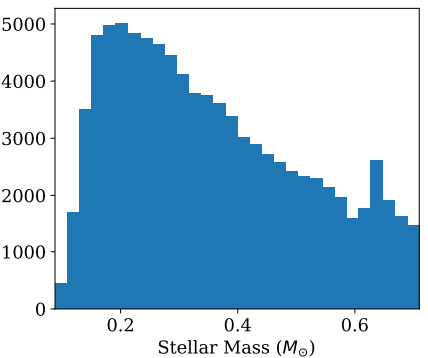
Their search of over 90,000 low-mass stars yielded 15 giant planet candidates, of which seven were not previously known.
The significance of the 15 giant planets they discovered is clear. A figure from their paper compares their sample with the full population of transiting giant exoplanets. “… it is evident that our search has extended the population of known transiting gas planets to lower stellar mass hosts than ever before,” they explain.
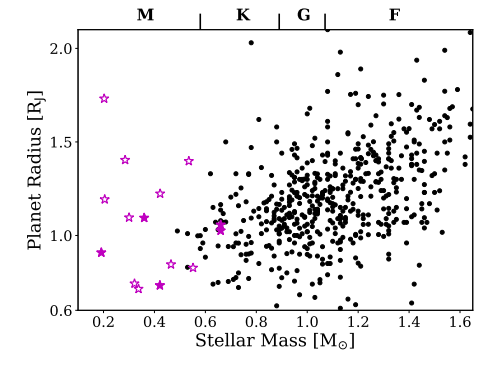
“There must be some pathway through which these stars can form giant planets.”
from “The occurrence rate of giant planets orbiting low-mass stars with TESS.”
So what do these findings mean for our theories of planetary formation? Lead author Bryant is a young scientist, and this paper is part of his Ph.D. He’s clearly excited by these findings and the questions they pose.
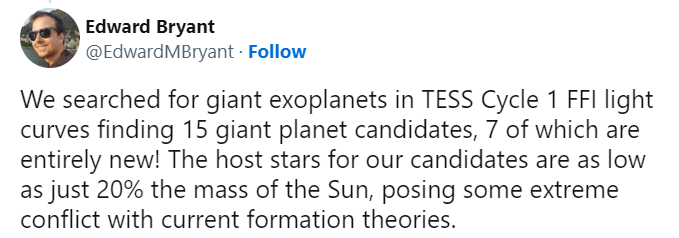
“The dependence of giant planet occurrence rates on the mass of the host star is a clear prediction of the core-accretion planet formation theory,” the authors explain. That theory predicts lower rates of giant planets around stars with less than one solar mass. But these results contradict both the theory and previous research. “However, our results show that close-in giant planets can and do exist for these low-mass host stars.”
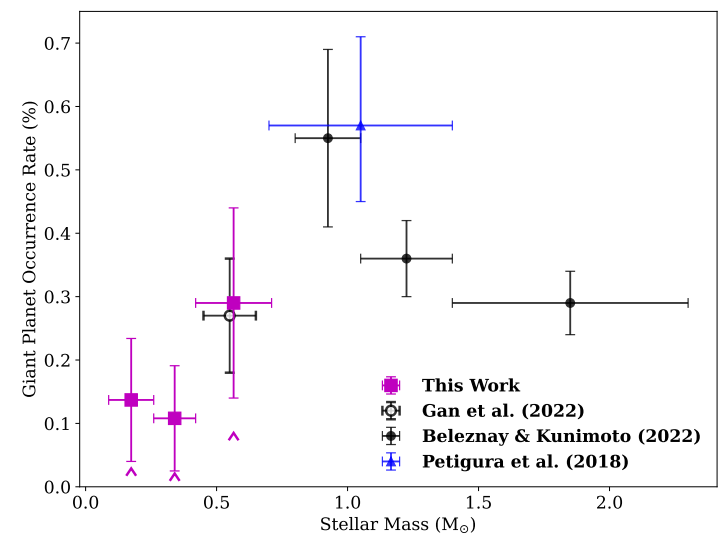
So if core accretion theory says that most of the 15 giant planets found in the study shouldn’t exist, what’s going on? Obviously, there’s some mechanism that allows them to form, and our theory is incomplete. “There must be some pathway through which these stars can form giant planets,” the authors write.
The primary impediment to massive stars is available mass in the protoplanetary disk. Scientists think that low-mass stars can only support low-mass disks. But even rare exceptions to that could explain these results. “Therefore, if these low-mass stars were capable of supporting much more massive disks than currently expected, even rarely, this would allow for the formation of these giant planets,” they explain.
‘More observations’ is a common refrain in science, and it fits in this case. “Observational studies of disk-hosting low-mass stars could allow the occurrence of such massive disks to be constrained,” the authors write. But estimating the masses of protoplanetary disks is an imperfect science, and it could be as simple as that: we don’t know how to accurately measure the mass.
More and better observations could clarify that, but there’s an obstacle. Very young protoplanetary disks are still embedded in gas clouds and obscured by a thick veil of gas. The disks could be more massive than we know. “As such, these disks could begin with a much higher mass than when we can observe them, and so it is possible that their initial masses are sufficient to support giant planet formation,” they write.

But the core accretion theory isn’t the only theory that attempts to explain how planets form. Its competitor is the disk instability theory. It says that planetary cores don’t form from the accretion of planetesimals. Instead, planetary cores form from gravitational instability in the disk as clumps of material fragment into planet-sized, self-gravitating chunks.
Could disk instability explain these planets? Recent research shows that they can.
“It has been shown that giant planets are capable of forming through this mechanism for host stars with masses as low as 0.1 solar masses,” the authors write. One study even showed that giant planets that form around low-mass stars via disk instability have high masses equal to or greater than 2 Jupiter masses. The authors point out that more observations are needed to determine if disk instability is at play for the 15 planets they found. “Spectroscopic follow-up of our candidates is required to measure their masses to determine whether they are massive planets that could have formed through gravitational instability,” they write.
Exactly how do the team’s results challenge core accretion theory?
Only part of their results casts doubt on core accretion. It all comes down to mass. The team’s results for the upper range of low-mass stars in their study do conform with the core accretion theory. But for stars with less than about 0.4 solar masses, core accretion is left wanting.
” … our results for the lower mass stars in our sample – less than or equal to 0.4 solar masses – present some conflict with the current understanding of how giant planets form,” they write. There simply shouldn’t be enough mass in the disk for these giant planets to form.
The authors point out that some confirmation is still needed. Some of their giant planets are still only candidates. In fact, two-thirds of them are unconfirmed. Confirming those candidates will only strengthen the researchers’ results, and that work is already underway.
“The work to obtain these confirmations is underway, and over the next few years, we hope to be able to improve our constraints on the occurrence rates as the follow-up effort continues,” they conclude.
The follow-up effort will involve the next generation of spectroscopic instruments. The ESO’s NIRPS (Near Infra Red Planet Searcher) is an infrared spectrograph designed to find rocky planets around the coldest stars, and its capabilities can help confirm candidate exoplanets like the ones in this research.
SPIRou (SPectropolarimètre InfraROUge) is a near-infrared spectropolarimeter that can take high-precision radial velocity measurements. SPIRou has the ability to search for exoplanets around low-mass stars and T Tauri stars, and it can also help confirm these exoplanets.
More:
- New Research: The occurrence rate of giant planets orbiting low-mass stars with TESS
- Paper: Disk Instability vs. Core Accretion: Observable Discriminants
- Universe Today: Planet Formation Doesn’t Have to be a Rush job After all

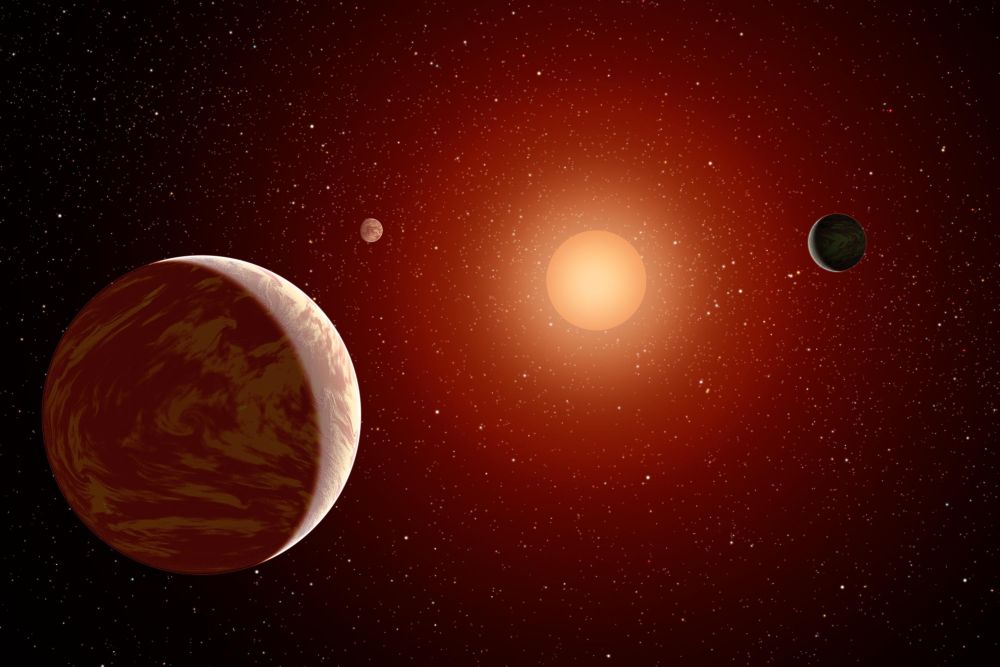
The paper use TESS for transit detection and screen for binaries through secondary in-plane eclipse detection. But what if the secondary is a Jupiter sized brown dwarf, with binary formation pathway presumably a variant of disk instability – disk fragmentation? We don’t know the initial disk mass distributions: “We also note that to date protoplanetary disks have not been observed at a very young age, as at these ages they are still embedded in gas clouds and hard to observe. As such, these disks could begin with a much higher mass than when we can observe them, and so it is possible that their initial masses are sufficient to support giant planet formation.”
It would perhaps be interesting to have the candidate masses as well as their confirmation before making any conclusions about putative formation pathways.